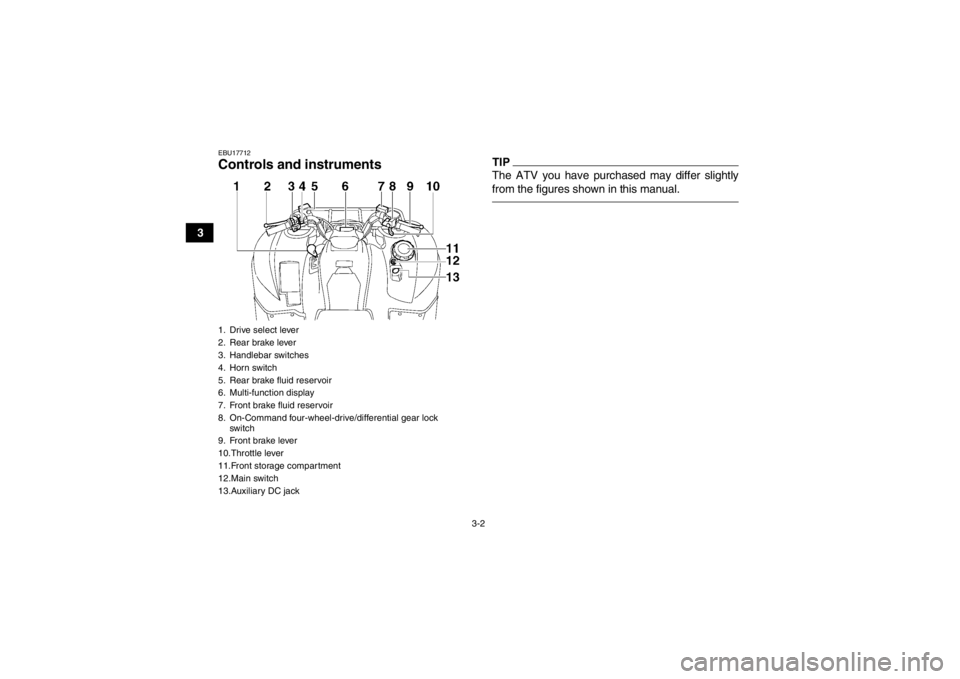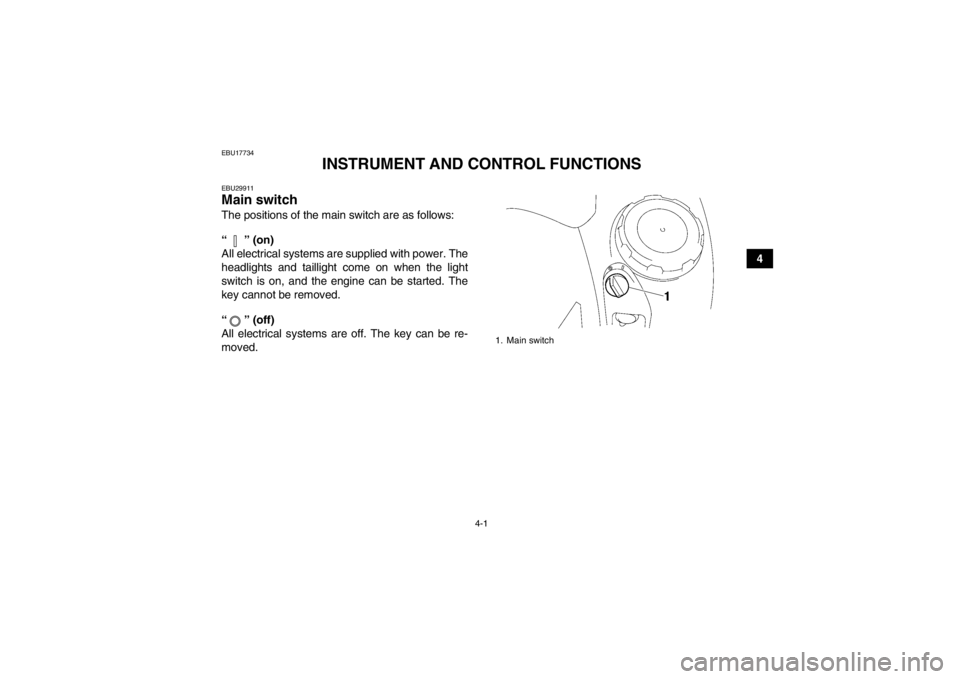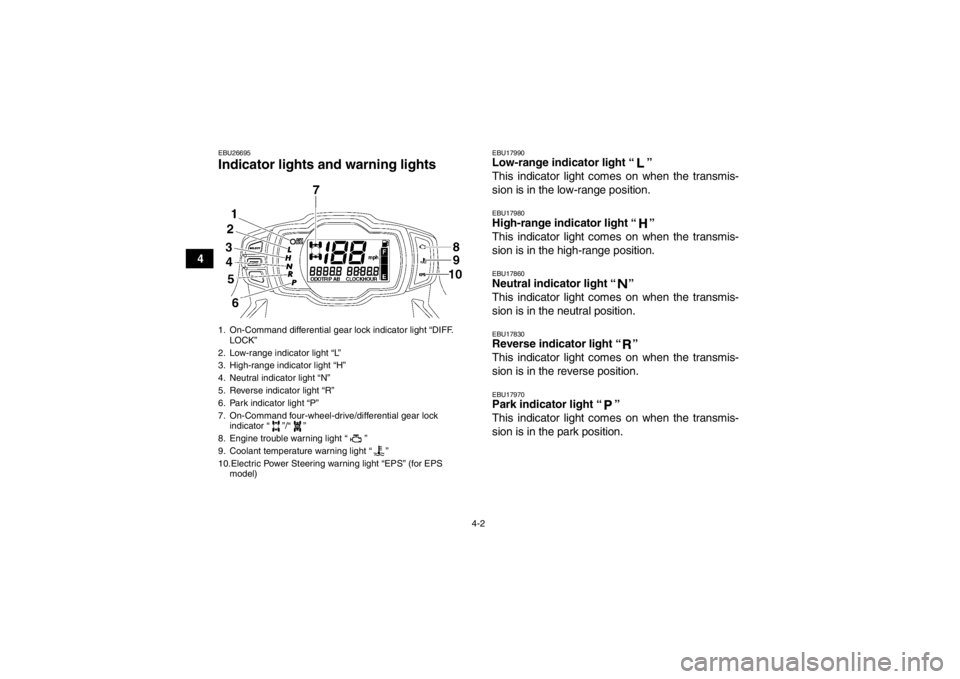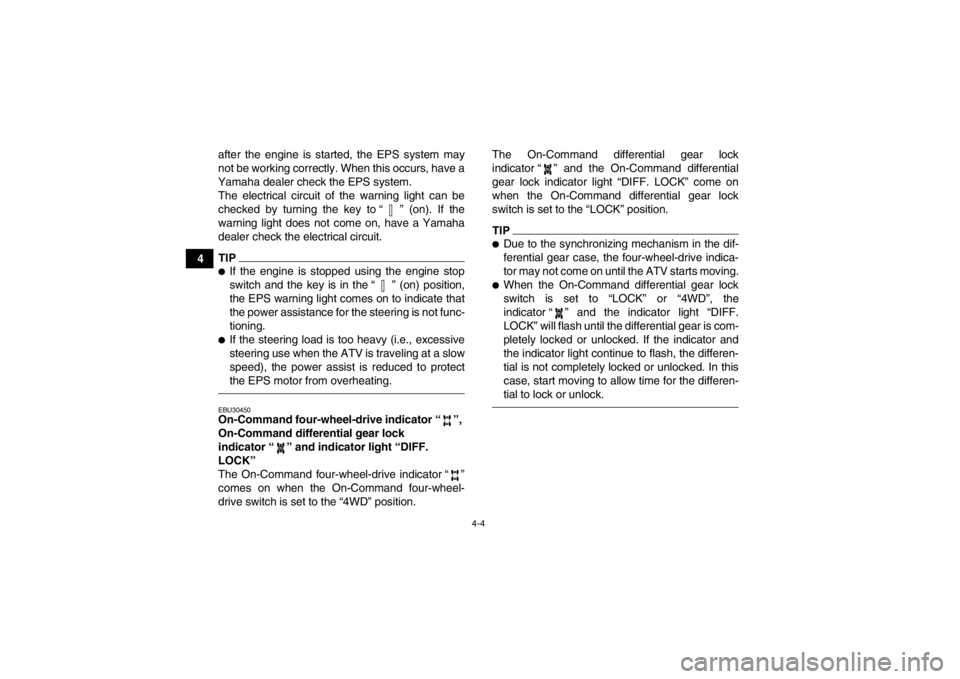light YAMAHA GRIZZLY 550 2014 Owners Manual
[x] Cancel search | Manufacturer: YAMAHA, Model Year: 2014, Model line: GRIZZLY 550, Model: YAMAHA GRIZZLY 550 2014Pages: 174, PDF Size: 4.2 MB
Page 9 of 174

EBU17420
TABLE OF CONTENTS
LOCATION OF THE WARNING AND
SPECIFICATION LABELS ............................ 1-1
SAFETY INFORMATION .............................. 2-1
DESCRIPTION .............................................. 3-1Left view ...................................................... 3-1
Right view.................................................... 3-1
Controls and instruments ............................ 3-2
INSTRUMENT AND CONTROL
FUNCTIONS .................................................. 4-1 Main switch ................................................ 4-1
Indicator lights and warning lights .............. 4-2
Multi-function display .................................. 4-5
Handlebar switches .................................... 4-7
Throttle lever ............................................ 4-13
Speed limiter ............................................ 4-13
Front brake lever ...................................... 4-14
Brake pedal and rear brake lever ............. 4-14
Drive select lever ...................................... 4-15
Fuel tank cap ............................................ 4-15
Fuel .......................................................... 4-16
Seat .......................................................... 4-18 Storage compartments .............................4-18
Front carrier ..............................................4-21
Rear carrier ...............................................4-21
Adjusting the front and rear shock
absorber assemblies ...............................4-21
Auxiliary DC jack .......................................4-23
PRE-OPERATION CHECKS ..........................5-1 Fuel .............................................................5-3
Engine oil ....................................................5-3
Final gear oil ...............................................5-3
Differential gear oil ......................................5-3
Coolant .......................................................5-3
Front and rear brakes .................................5-3
Throttle lever ...............................................5-4
Tires ............................................................5-4
Chassis fasteners .......................................5-7
Instruments, lights and switches .................5-7
OPERATION...................................................6-1 Starting the engine ......................................6-1
Operating the drive select lever and driving in reverse ......................................6-2
Engine break-in ...........................................6-4U2LB60E0.book Page 1 Thursday, March 21, 2013 10:20 AM
Page 11 of 174

Checking the wheel hub bearings ............ 8-54
Checking the stabilizer bushes ................ 8-54
Lubricating the rear knuckle pivots ........... 8-55
Lubricating the steering shaft ................... 8-55
Battery ...................................................... 8-55
Replacing a fuse ...................................... 8-59
Replacing a headlight bulb ....................... 8-61
Adjusting a headlight beam ...................... 8-63
Replacing the tail/brake light bulb ............ 8-63
Removing a wheel .................................... 8-64
Installing a wheel ...................................... 8-65
Troubleshooting ....................................... 8-66
Troubleshooting charts ............................. 8-67
CLEANING AND STORAGE .......................... 9-1 Cleaning ..................................................... 9-1
Storage ....................................................... 9-2
SPECIFICATIONS ...................................... 10-1
CONSUMER INFORMATION ...................... 11-1 Identification numbers .............................. 11-1
U2LB60E0.book Page 3 Thursday, March 21, 2013 10:20 AM
Page 25 of 174

2-3
2
●Always use proper procedures if you stall or roll
backwards when climbing a hill. To avoid stall-
ing, use the proper gear range and maintain a
steady speed when climbing a hill. If you stall or
roll backwards, follow the special procedure for
braking described in this manual. Dismount on
the uphill side or to a side if pointed straight up-
hill. Turn the ATV around and remount, following
the procedure described in this manual.●Always check for obstacles before operating in a
new area.●Never attempt to operate over large obstacles,
such as large rocks or fallen trees. Always follow
proper procedures when operating over obsta-
cles as described in this manual.●Always be careful when skidding or sliding.
Learn to safely control skidding or sliding by
practicing at low speeds and on level, smooth
terrain. On extremely slippery surfaces, such as
ice, go slowly and be very cautious in order to re-
duce the chance of skidding or sliding out of con-
trol.●Never operate an ATV in fast flowing water or in
water deeper than that recommended in this
manual. Remember that wet brakes may havereduced stopping ability. Test your brakes after
leaving water. If necessary, apply them several
times to let friction dry out the linings.
●Always be sure there are no obstacles or people
behind you when you operate in reverse. When
it is safe to proceed in reverse, go slowly.●Always use the size and type of tires specified in
this manual.●Always maintain proper tire pressure as de-
scribed in this manual.●Never exceed the stated load capacity for an
ATV. Cargo should be properly distributed and
securely attached. Reduce speed and follow in-
structions in this manual for carrying cargo or
pulling a trailer. Allow greater distance for brak-
ing.●Do not operate your ATV during darkness un-
less it is equipped with a properly functioning
headlight. Off-road riding is inherently danger-
ous and additionally, off-road trails do not have
streetlights to guide you.●Never maintain an ATV without proper knowl-
edge. Contact an authorized ATV dealer to in-
form you on basic ATV maintenance. Certain
maintenance can only be carried out by certified
staff.
U2LB60E0.book Page 3 Thursday, March 21, 2013 10:20 AM
Page 26 of 174

2-4
2In the event of an accident
1. If serious injuries are incurred, you may be safer staying next to your vehicle; it may
shield you from oncoming riders. Depending
on your injuries and position in the trail; you
must make a judgment call as to whether you
should move to a position off the trail. If you
have sustained head, neck, or back injuries,
or cannot feel your limbs, you should not
move. Keep your helmet on and remain mo-
tionless. Lie down next to your vehicle and
wait for help.
2. If less serious injuries are incurred and you can walk, then move to a position off the trail.
Check yourself for injuries and apply first aid
as needed.
3. If your injuries are light, when safe to do so, move your vehicle off the trail to avoid colli-
sions with oncoming riders. Check for injuries
and apply first aid as necessary. If you can
physically operate your vehicle, inspect your
vehicle. If the vehicle is in safe operating con-
dition and you can safely operate it, restart it
and ride gently back to camp or other known
location where you can receive medical atten- tion. If necessary, contact your riding party or
local authorities to let them know where you
are and what has happened.
In the event of a breakdown 1. If your vehicle will not restart or is not in safe operating condition, turn off the main switch
and engine stop switch. If the breakdown oc-
curs at twilight or night, leave the main switch
on so that your lights may warn other riders of
your stopped vehicle.
2. Get out of danger. Check for oncoming vehi- cles and when safe, push your vehicle to the
side of the trail or even off the main trail to
avoid any possible collisions with oncoming
riders. If you cannot move your vehicle by
yourself, when safe, walk to the nearest van-
tage point and signal an oncoming rider to
help you push your vehicle to a safe place off
the trail.
3. Inspect your vehicle for any immediate haz- ardous conditions. The most obvious hazard-
ous conditions are leaking fuel and
ungrounded or broken wiring. Visually check
for broken wiring and leaking fuel. Leaking
fuel can be confirmed by the odor of gasoline.
U2LB60E0.book Page 4 Thursday, March 21, 2013 10:20 AM
Page 27 of 174

2-5
2
4. Once immediate safety hazards are con-
firmed not to exist, you may remove your hel-
met to more closely inspect your vehicle.
Check for external signs of wear, broken
parts, fluid leaks, cracks in the frame, suspen-
sion damage, wheel damage, and so on. Fuel,
oil, and coolant usually give off a noticeable
odor.
5. If your vehicle will not restart or if it is unsafe to ride, then turn off all vehicle systems (en-
gine stop switch, main switch, and fuel cock),
and then signal or go for help.
Aftermarket Parts, Accessories, and Modifica-
tions
While you may find aftermarket products similar in
design and quality to genuine Yamaha accesso-
ries, recognize that some aftermarket accessories
or modifications are not suitable because of poten-
tial safety hazards to you or others. Installing after-
market products or having other modifications
performed to your vehicle that change any of the
vehicle’s design or operation characteristics can
put you and others at greater risk of serious injury
or death. You are responsible for injuries related to changes in the vehicle. Keep the following guide-
lines in mind, as well as those provided under
“Loading” when mounting accessories.
●Never install accessories that would impair the
performance of your ATV. Carefully inspect the
accessory before using it to make sure that it
does not in any way reduce ground clearance,
limit suspension travel, steering travel or control
operation.●Accessories fitted to the ATV can create instabil-
ity due to improper weight distribution.●Bulky or large accessories may seriously affect
the stability of the ATV.●Certain accessories can displace the operator
from his or her normal riding position. This im-
proper position limits the freedom of movement
of the operator and may limit control ability,
therefore, such accessories are not recom-
mended.●Use caution when adding electrical accessories.
If electrical accessories exceed the capacity of
the ATV’s electrical system, an electric failure
could result, which could cause a dangerous
loss of lights or engine power.
U2LB60E0.book Page 5 Thursday, March 21, 2013 10:20 AM
Page 30 of 174

3-2
3
EBU17712Controls and instruments
TIPThe ATV you have purchased may differ slightly
from the figures shown in this manual.
1. Drive select lever
2. Rear brake lever
3. Handlebar switches
4. Horn switch
5. Rear brake fluid reservoir
6. Multi-function display
7. Front brake fluid reservoir
8. On-Command four-wheel-drive/differential gear lock switch
9. Front brake lever
10.Throttle lever
11.Front storage compartment
12.Main switch
13.Auxiliary DC jackU2LB60E0.book Page 2 Thursday, March 21, 2013 10:20 AM
Page 31 of 174

4-1
4
EBU17734
INSTRUMENT AND CONTROL FUNCTIONS
EBU29911Main switch The positions of the main switch are as follows:
“” (on)
All electrical systems are supplied with power. The
headlights and taillight come on when the light
switch is on, and the engine can be started. The
key cannot be removed.
“ ” (off)
All electrical systems are off. The key can be re-
moved.
1. Main switch
U2LB60E0.book Page 1 Thursday, March 21, 2013 10:20 AM
Page 32 of 174

4-2
4
EBU26695Indicator lights and warning lights
EBU17990Low-range indicator light “ ”
This indicator light comes on when the transmis-
sion is in the low-range position.EBU17980High-range indicator light “ ”
This indicator light comes on when the transmis-
sion is in the high-range position.EBU17860Neutral indicator light “ ”
This indicator light comes on when the transmis-
sion is in the neutral position.EBU17830Reverse indicator light “ ”
This indicator light comes on when the transmis-
sion is in the reverse position.EBU17970Park indicator light “ ”
This indicator light comes on when the transmis-
sion is in the park position.
1. On-Command differential gear lock indicator light “DIFF. LOCK”
2. Low-range indicator light “L”
3. High-range indicator light “H”
4. Neutral indicator light “N”
5. Reverse indicator light “R”
6. Park indicator light “P”
7. On-Command four-wheel-drive/differential gear lock indicator “ ”/“ ”
8. Engine trouble warning light “ ”
9. Coolant temperature warning light “ ”
10.Electric Power Steering warning light “EPS” (for EPS model)U2LB60E0.book Page 2 Thursday, March 21, 2013 10:20 AM
Page 33 of 174

4-3
4
EBU30530Coolant temperature warning light “ ”
This warning light comes on when the engine over-
heats. When this occurs during operation, stop the
engine as soon as it is safe to do so and allow it to
cool down for about 10 minutes.
The electrical circuit of the warning light can be
checked by turning the key to “ ” (on). The warn-
ing light should come on for a few seconds, and
then go off.
If the warning light does not come on initially when
the key is turned to “ ” (on), or if the warning light
remains on, have a Yamaha dealer check the elec-
trical circuit.NOTICEECB00891●The engine may overheat if the ATV is over-
loaded. In this case, reduce the load to spec-
ification.●The engine may also overheat if mud or dirt
has accumulated on the radiator (i.e., after
riding in wet terrain). In this case, see page
8-19 for an explanation on how to access the
radiator.
●Start the engine after making sure that the
warning light is out. Continuous use while
the warning light is on may cause damage to
the engine.EBU30480Engine trouble warning light “ ”
This warning light comes on or flashes when an
electrical circuit monitoring the engine is not work-
ing correctly. When this occurs, have a Yamaha
dealer check the self-diagnosis system. (See page
4-7 for an explanation of the self-diagnosis device.)
The electrical circuit of the warning light can be
checked by turning the key to “ ” (on). The warn-
ing light should come on for a few seconds, and
then go off.
If the warning light does not come on initially when
the key is turned to “ ” (on), or if the warning light
remains on, have a Yamaha dealer check the elec-
trical circuit.EBU30570Electric Power Steering warning light “EPS”
(for EPS model)
This warning light comes on when the key is turned
to “ ” (on), and then goes off once the engine is
started. If the warning light remains on or comes on
U2LB60E0.book Page 3 Thursday, March 21, 2013 10:20 AM
Page 34 of 174

4-4
4after the engine is started, the EPS system may
not be working correctly. When this occurs, have a
Yamaha dealer check the EPS system. The electrical circuit of the warning light can be
checked by turning the key to “ ” (on). If the
warning light does not come on, have a Yamaha
dealer check the electrical circuit.
TIP●If the engine is stopped using the engine stop
switch and the key is in the “ ” (on) position,
the EPS warning light comes on to indicate that
the power assistance for the steering is not func-
tioning.●If the steering load is too heavy (i.e., excessive
steering use when the ATV is traveling at a slow
speed), the power assist is reduced to protect
the EPS motor from overheating.EBU30450On-Command four-wheel-drive indicator “ ”,
On-Command differential gear lock
indicator “ ” and indicator light “DIFF.
LOCK”
The On-Command four-wheel-drive indicator “ ”
comes on when the On-Command four-wheel-
drive switch is set to the “4WD” position. The On-Command differential gear lock
indicator “ ” and the On-Command differential
gear lock indicator light “DIFF. LOCK” come on
when the On-Command differential gear lock
switch is set to the “LOCK” position.
TIP●Due to the synchronizing mechanism in the dif-
ferential gear case, the four-wheel-drive indica-
tor may not come on until the ATV starts moving.●When the On-Command differential gear lock
switch is set to “LOCK” or “4WD”, the
indicator “ ” and the indicator light “DIFF.
LOCK” will flash until the differential gear is com-
pletely locked or unlocked. If the indicator and
the indicator light continue to flash, the differen-
tial is not completely locked or unlocked. In this
case, start moving to allow time for the differen-
tial to lock or unlock.
U2LB60E0.book Page 4 Thursday, March 21, 2013 10:20 AM